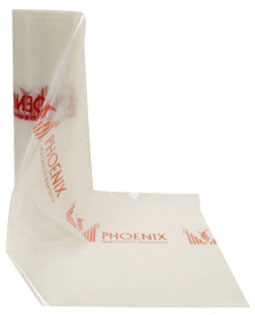Lay Flat Duct 19" Diameter X 500’ Length

Features
• Lay Flat Duct For Negative Air Machines
• 2.25 Mil Thick
• 19" (22" Circumference) x 500’
• Clear
When you require Lay Flat Ducting for your Air Scrubber, Negative Air Machine or dehumidifier, choose a tough product that holds up over the long haul. This duct will cover 12" as well as 14" exhaust ports. Custom-cut just the amount you need and store the rest!
VIEW IN OUR STOREThe Benefits of Lay Flat Ventilation Ducting
When you’re working with negative air, the last thing you want to worry about is ductwork. If you have a dehumidifier, air scrubber, or other machine that needs to be safely and effectively ventilated, many contractors and homeowners rely on lay flat ductwork. This fantastic product comes in a large roll, so you can cut as much as you need to suit the exhaust needs of your project, then store the rest.
Join us to learn more about lay flat ventilation ducting and how it can be used domestically and commercially to ensure optimal, efficient airflow.
How Does Lay Flat Ducting Work?
Unlike traditional round ductwork, lay flat ducting is made of very thin plastic, usually between 2.25 and 6 mil thick. First, one end is attached to a negative air machine like a dehumidifier or air scrubber using a clamp ring. Then, the lay flat ventilation duct is laid out in a pattern that allows it to expand and contract as needed. The material's flexibility ensures easy maneuverability around corners, through tight spaces, and across various surfaces, making it a versatile solution for different ventilation setups.
While this ducting material is thin and lightweight, it’s also very durable, ensuring a reliable performance even in demanding conditions. The ducting's ability to lay flat when not in use and expand during operation makes it convenient for storage and even more efficient during setup.
The Benefits of Lay Flat Duct
Here are some reasons you may want to choose lay flat duct for your next project.
-
Space efficiency:
One of the standout advantages of lay flat ducting is its space-saving design. When not in use, it can be neatly rolled and stored in a compact space. This feature is particularly beneficial for contractors and homeowners with a limited storage capacity, allowing them to manage equipment and materials more effectively.
-
Customizable:
Having a roll of lay flat ducting allows users to cut it to their desired length, providing a tailored solution for each project. This customization not only reduces waste but also ensures a snug fit for optimal airflow.
-
Quick setup:
Lay flat ventilation ducting is renowned for its ease of use and rapid deployment. With a simple clamp ring attachment, users can have the ducting in place on their negative air machine in just a few minutes.
-
Adaptability:
The ability of lay flat ducting to conform to different shapes and sizes makes it highly adaptable. It can navigate obstacles and reach distant areas with ease, providing a solution for challenging ventilation scenarios.
- Cost-effective: From a cost perspective, lay flat ventilation ducting offers fantastic value for money. Its durable construction means it can withstand repeated use, reducing the need for frequent replacements.
FAQs
1. What is lay flat ducting used for?
Lay flat ducting is primarily used to safely and efficiently ventilate negative air generated by dehumidifiers, air scrubbers, or similar machines. Its flexibility and customizable lengths make it suitable for various applications, from construction sites to restoration projects.
2. What is the difference between flat and round ducting?
The main difference lies in their shape and construction. Lay flat ducting is thin and flexible, designed for easy maneuverability and storage. In contrast, round ducting is rigid and typically used in more permanent installations. The choice between them depends on specific project requirements and space constraints.






